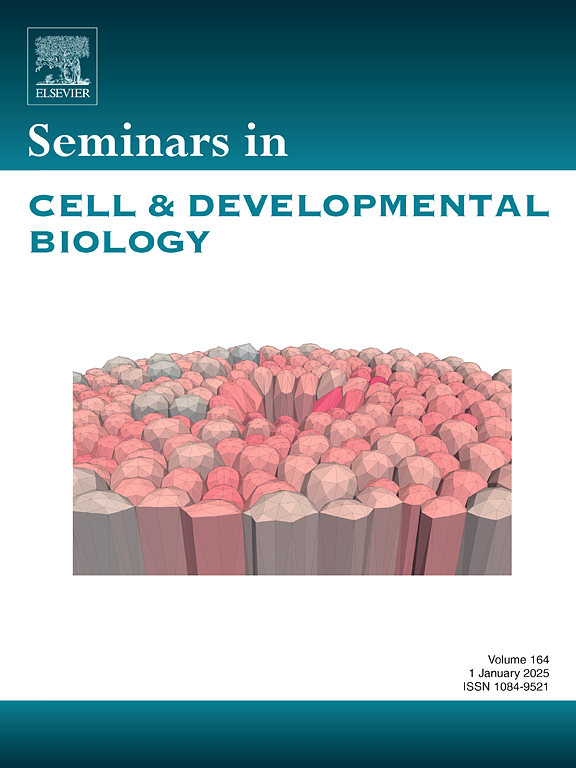哺乳动物活动纤毛:结构、形成、组织和功能
IF 6
2区 生物学
Q1 CELL BIOLOGY
引用次数: 0
摘要
纤毛是一种被膜覆盖的毛发状细胞器,建立在特殊的中心粒上,在真核生物的进化过程中一直保存着。它们要么是活动的,要么是不活动的,分别充当多功能信号天线或优雅的跳动纳米机器。因此,它们的功能障碍引起各种各样的发育和退行性疾病,这些疾病在人类中被称为纤毛病。哺乳动物的活动纤毛存在于上皮细胞中。它们快速、有节奏的跳动通过促进定向配子运输、淋巴结流动、脑脊液循环和粘液清除来促进生殖、左右模式和器官稳态。它们大多合并成多毛细胞,每个细胞多达数百个。多毛细胞不仅需要打破细胞对中心粒生物发生的严格控制,确保其形成的众多结构成分的精确组装,而且需要正确组织和极化它们以实现其功能。本文以小鼠为模型生物,对哺乳动物运动纤毛的细胞生物学进行了综述。本文章由计算机程序翻译,如有差异,请以英文原文为准。
Mammalian motile cilia: Structure, formation, organization, and function
Cilia are membrane-covered hair-like organelles built on specialized centrioles and conserved throughout eukaryotic evolution. They are either motile or immotile, serving respectively as versatile signaling antennae or elegant beating nanomachines. Accordingly, their dysfunctions cause a wide variety of developmental and degenerative disorders, which in human are syndromes termed ciliopathies. Motile cilia in mammals reside in epithelial cells. Their rapid, rhythmic beating facilitates reproduction, left-right patterning, and organ homeostasis by propelling directional gamete transport, nodal flow, cerebrospinal fluid circulation, and mucus clearance. They merge mostly as multicilia, with up to hundreds per cell. Multiciliated cells need not only to break the tight cellular control on centriole biogenesis and ensure accurate assemblies of numerous structural components for their formations, but to properly organize and polarize them for their functions as well. This review mainly focuses on the cell biology of mammalian motile cilia, with the mouse as the model organism.
求助全文
通过发布文献求助,成功后即可免费获取论文全文。
去求助
来源期刊
CiteScore
15.10
自引率
1.40%
发文量
310
审稿时长
9.1 weeks
期刊介绍:
Seminars in Cell and Developmental Biology is a review journal dedicated to keeping scientists informed of developments in the field of molecular cell and developmental biology, on a topic by topic basis. Each issue is thematic in approach, devoted to an important topic of interest to cell and developmental biologists, focusing on the latest advances and their specific implications.
The aim of each issue is to provide a coordinated, readable, and lively review of a selected area, published rapidly to ensure currency.

 求助内容:
求助内容: 应助结果提醒方式:
应助结果提醒方式:


